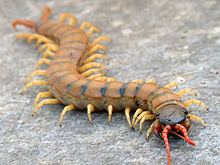Scolopendridae
| Scolopendridae Temporal range: Early Cretaceous to present
| |
|---|---|

| |
| Scolopendra cingulata | |
| Scientific classification | |
| Domain: | Eukaryota |
| Kingdom: | Animalia |
| Phylum: | Arthropoda |
| Subphylum: | Myriapoda |
| Class: | Chilopoda |
| Order: | Scolopendromorpha |
| Family: | Scolopendridae Newport, 1844 |
| Genera | |
|
See text. | |
Scolopendridae (or, in older documents, Scolopendridæ)[1] is a family of large centipedes (class Chilopoda).
Description[edit]
Nearly all species in this family have four ocelli (simple eyes) on each side of the head and only 21 pairs of legs, but there are exceptions: two scolopendrid species feature more legs (Scolopendropsis bahiensis, with 21 or 23 leg pairs,[2] and S. duplicata, with 39 or 43 leg pairs),[3] and some scolopendrid species are eyeless and blind (e.g., Cormocephalus sagmus, C. pyropygus, and C. delta).[4][5] Three Asian members of this family, Scolopendra cataracta, Scolopendra paradoxa, and Scolopendra alcyona, are known to show amphibious behaviour.[6][7][8][9][10][11] Two other species, Scolopendra hardwickei and Hemiscolopendra marginata, are known to show sexual dimorphism in the composition of their venom.[12][13]
Genera[edit]
Subfamily Otostigminae (Kraepelin, 1903)[14][15][edit]
Tribe Otostigmini (Kraeplin, 1903)[16][edit]
- Alipes Imhoff, 1854
- Alluropus Silvestri, 1911
- Digitipes Attems, 1930
- Edentistoma Tömösváry,1882
- Ethmostigmus Pocock, 1898
- Otostigmus Porat, 1876
- Rhysida Wood, 1862
Tribe Sterropristini (Verhoeff, 1937) [17][18][edit]
- Sterropristes Attems, 1934
Subfamily Scolopendrinae (Leach, 1814)[19][14][edit]
- Arthrorhabdus Pocock, 1891 (= Arthrorhabdinus)
- Asanada Meinert, 1885 (= Pseudocryptops)
- Asanadopsis Würmli, 1972
- Campylostigmus Ribaut, 1923
- Notiasemus Koch, 1985
- Procrytops Piton, 1940
- Psiloscolopendra Kraepelin, 1903
- Rhoda Meinert, 1886 (= Pithopus)
- Scolopendra Linnaeus, 1758
- Scolopendropsis Brandt, 1841
- Tonkinodentus Schileyko, 1992
The earliest record of this family is †Cratoraricrus, an extinct genus from the Early Cretaceous of the Crato Formation of Brazil.[20]
References[edit]
- ^ The Annals and magazine of natural history; zoology, botany, and geology. Vol. 7. London: Taylor and Francis, Ltd. 1891.
- ^ Schileyko, Arkady A. (2006). "Redescription of Scolopendropsis bahiensis (Brandt, 1841), the relations between Scolopendropsis and Rhoda, and notes on some characters used in scolopendromorph taxonomy (Chilopoda: Scolopendromorpha)". Arthropoda Selecta. 15 (1): 9–17 – via ResearchGate.
- ^ Chagas-Junior, Amazonas; Edgecombe, Gregory D.; Minelli, Alessandro (2008-09-29). "Variability in trunk segmentation in the centipede order Scolopendromorpha: a remarkable new species of Scolopendropsis Brandt (Chilopoda: Scolopendridae) from Brazil". Zootaxa. 1888 (1): 36. doi:10.11646/zootaxa.1888.1.2. ISSN 1175-5334. S2CID 86220862.
- ^ Jiang, Chao; Bai, Yunjun; Shi, Mengxuan; Liu, Juan (2020-12-05). "Rediscovery and phylogenetic relationships of the scolopendromorph centipede Mimops orientalis Kraepelin, 1903 (Chilopoda): a monotypic species of Mimopidae endemic to China, for more than one century". ZooKeys (932): 75–91. doi:10.3897/zookeys.932.51461. ISSN 1313-2970. PMC 7239954. PMID 32476974.
- ^ Edgecombe, Gregory D.; Huey, Joel A.; Humphreys, William F.; Hillyer, Mia; Burger, Mieke A.; Volschenk, Erich S.; Waldock, Julianne M. (2019). "Blind scolopendrid centipedes of the genus Cormocephalus from subterranean habitats in Western Australia (Myriapoda: Scolopendromorpha: Scolopendridae)". Invertebrate Systematics. 33 (6): 807–824. doi:10.1071/IS19015. ISSN 1445-5226. S2CID 209585200.
- ^ Anderson, Natali (2021-04-22). "Scientists Discover New Amphibious Species of Centipede | Sci.News". Sci.News: Breaking Science News. Retrieved 2022-09-06.
- ^ Holmes, O. (1 July 2016). "Giant swimming, venomous centipede discovered by accident in world-first". The Guardian. Retrieved 1 July 2016.
- ^ Bates, M. (26 June 2016). "'Horrific' First Amphibious Centipede Discovered". National Geographic. Archived from the original on June 26, 2016. Retrieved 1 July 2016.
- ^ Gravely, F.H. ″Two new species of Scolopendridae″, Records of the Indian Museum, Volume 7, 1912, p. 415
- ^ Siriwut, W.; Edgecombe, G. D.; Sutcharit, C.; Tongkerd, P.; Panha, S. (2016). "A taxonomic review of the centipede genus Scolopendra Linnaeus, 1758 (Scolopendromorpha, Scolopendridae) in mainland Southeast Asia, with description of a new species from Laos". ZooKeys (590): 1–124. doi:10.3897/zookeys.590.7950. PMC 4926625. PMID 27408540.
- ^ "Centipede". VEDANTU. Retrieved 2022-09-06.
- ^ Undheim, Eivind & Richards, David & Ngum, Neville & Tooth, David & Kim, Dong-Hyun & Mellor, Ian. (2019). When sex matters: Dramatic sexual dimorphism in the venom and venom system of the centipede Scolopendra hardwickei. Toxicon. 158. S5. 10.1016/j.toxicon.2018.10.024.
- ^ Nystrom, Gunnar S.; Ward, Micaiah J.; Ellsworth, Schyler A.; Rokyta, Darin R. (Nov 2019). "Sex-based venom variation in the eastern bark centipede (Hemiscolopendra marginata)". Toxicon. 169: 45–58. doi:10.1016/j.toxicon.2019.08.001. ISSN 1879-3150. PMID 31445069. S2CID 201644874.
- ^ a b "Scolopendridae Leach 1814 - Encyclopedia of Life". eol.org. Retrieved 2022-08-29.
- ^ "ITIS - Report: Otostigminae". www.itis.gov. Retrieved 2022-12-25.
- ^ "Otostigmini Kraepelin 1903". www.gbif.org. Retrieved 2022-12-25.
- ^ "Sterropristini Verhoeff 1937". www.gbif.org. Retrieved 2022-12-25.
- ^ Muadsub, Sawitree; Sutcharit, Chirasak; Pimvichai, Piyatida; Enghoff, Henrik; Edgecombe, Gregory D.; Panha, Somsak (2012-09-14). "Revision of the rare centipede genus Sterropristes Attems, 1934, with description of a new species from Thailand (Chilopoda: Scolopendromorpha: Scolopendridae)". Zootaxa. 3484 (1): 35. doi:10.11646/zootaxa.3484.1.2. ISSN 1175-5334.
- ^ "ITIS - Report: Scolopendrinae". www.itis.gov. Retrieved 2022-08-29.
- ^ "Fossilworks: Cratoraricrus oberlii". fossilworks.org. Retrieved 17 December 2021.
External links[edit]
thumb ZAMN
